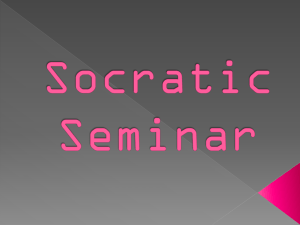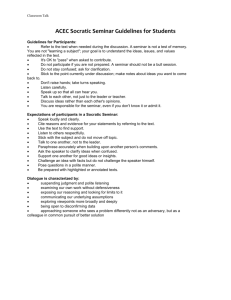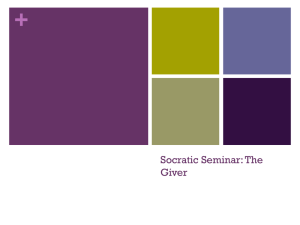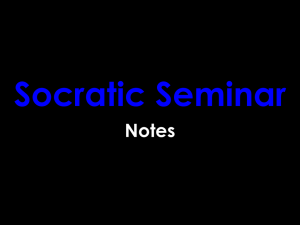Socratic Seminar on Thomas Friedman`s Article on the Global
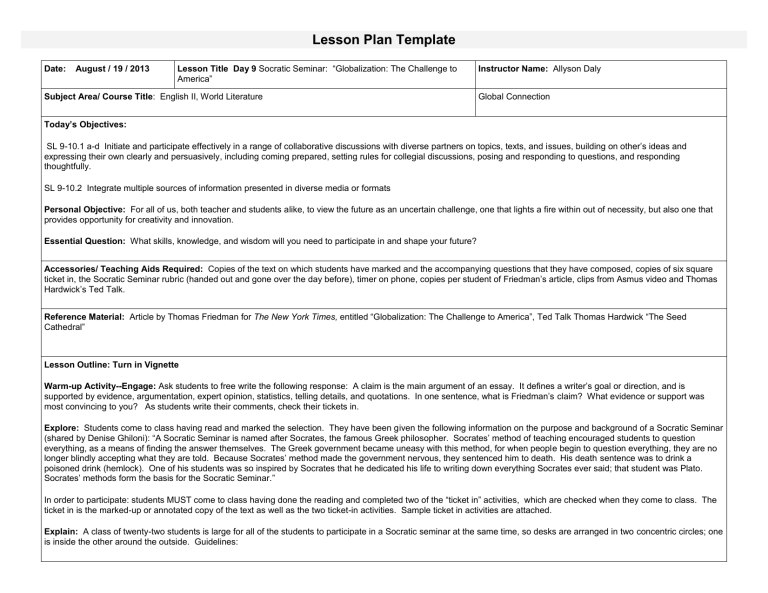
Lesson Plan Template
Date: August / 19 / 2013 Lesson Title Day 9 Socratic Seminar : “Globalization: The Challenge to
America”
Subject Area/ Course Title : English II, World Literature
Instructor Name: Allyson Daly
Global Connection
Today’s Objectives:
SL 9-10.1 a-d Initiate and participate effectively in a range of collaborative discussions with diverse partners on topics, texts, and i ssues, building on other’s ideas and expressing their own clearly and persuasively, including coming prepared, setting rules for collegial discussions, posing and responding to questions, and responding thoughtfully.
SL 9-10.2 Integrate multiple sources of information presented in diverse media or formats
Personal Objective: For all of us, both teacher and students alike, to view the future as an uncertain challenge, one that lights a fire within out of necessity, but also one that provides opportunity for creativity and innovation.
Essential Question: What skills, knowledge, and wisdom will you need to participate in and shape your future?
Accessories/ Teaching Aids Required: Copies of the text on which students have marked and the accompanying questions that they have composed, copies of six square ticket in, the Socratic Seminar rubric (handed out and gone over the day before), timer on phone, copies per student of Friedman’s article, clips from Asmus video and Thomas
Hardwick’s Ted Talk.
Reference Material: Article by Thomas Friedman for The New York Times, entitled “Globalization: The Challenge to America”, Ted Talk Thomas Hardwick “The Seed
Cathedral”
Lesson Outline: Turn in Vignette
Warm-up Activity--Engage:
Ask students to free write the following response: A claim is the main argument of an essay. It defines a writer’s goal or direction, and is supported by evidence, argumentation, expert opinion, statistics, telling details, and quotations. In one sentence, what is Friedman’s claim? What evidence or support was most convincing to you? As students write their comments, check their tickets in.
Explore: Students come to class having read and marked the selection. They have been given the following information on the purpose and background of a Socratic Seminar
(shared by Denise Ghiloni): “A Socratic Seminar is named after Socrates, the famous Greek philosopher. Socrates’ method of teaching encouraged students to question everything, as a means of finding the answer themselves. The Greek government became uneasy with this method, for when people begin to question everything, they are no longer blindly accepting what they are told. Because Socrates’ method made the government nervous, they sentenced him to death. His death sentence was to drink a poisoned drink (hemlock). One of his students was so inspired by Socrates that he dedicated his life to writing down everything Socrates ever said; that student was Plato.
Socrates’ methods form the basis for the Socratic Seminar.”
In order to participate: students MUST come to class having done the reading and c ompleted two of the “ticket in” activities, which are checked when they come to class. The ticket in is the marked-up or annotated copy of the text as well as the two ticket-in activities. Sample ticket in activities are attached.
Explain: A class of twenty-two students is large for all of the students to participate in a Socratic seminar at the same time, so desks are arranged in two concentric circles; one is inside the other around the outside. Guidelines:
Only students sitting inside the circle may speak when the discussion starts. Positive behaviors for inside circle participants are: being prepared, inviting others into the discussion, referring to the text, listening to and building upon others’ comments. Remember that you are not expected to raise your hands.
The students on the outside are listening and taking notes as assigned. NOTE: They are preparing to be members of the inside circle by observing the discussion and watching one member of the discussion closely.
Allow ten to fifteen minutes for each round of discussion, followed by five minutes of feedback from the outside circle.
The inner circle’s discussion should start with a rereading or summary of the text. They should then proceed to their dialogue. After the first inside circle’s discussion ends, allow for feedback from the outside circle. The students receiving feedback may not respond.
The two groups reverse roles and seats.
The teacher facilitates the discussion. If the key concepts have not been addressed, the teacher may pose these questions after the discussion.
Elaborate (Procedure):
2-3 minutes to set up, take out tickets, writing utensils, and arrange seating.
3 minutes: Inner circle rereads or summarizes the passage to be discussed.
10 minutes: Inner circle discussion
5 minutes: Outer circle response/ feedback
-----SWITCH SEATS-----
3 minutes: Inner circle rereads or summarizes the passage to be discussed
10 minutes: Inner circle discussion
5 minutes: Outer circle response/ feedback
5 minutes: Whole class responds to the activity (written)
Questions for the Socratic Seminar:
Remind students that the questions they have prepared are needed to fully develop the seminar. They should ask them as we move through the discussion.
What is globalization?
What is Friedman’s claim? Do you agree? Why or why not?
What support offered is the most convincing?
Which people will Americans most likely be competing against for jobs? What is making them competitive?
How are Americans characterized in this article? Where in the text do you see these characterizations? Do you agree with these characterizations?
Why has America failed to see that the global market place is changing?
What important events set these changes in motion?
In what order does Friedman place his evidence? Why do you think he lists it this way?
What does this mean to us? Why do we need to think about this topic?
What skills, knowledge, and wisdom will we need in order to participate and shape our future?
Closure:
Show clip from Thomas Hardwick’s Ted Talk “The Seed Cathedral,” emphasizing the innovative structures he creates, especially the bridge 4 minutes in, and the modern concept for apartment buildings, at
14 minutes. Compare and contrast Hardwick’s and Friedman’s claims. On what points do they seem to agree? On what points does each focus differ? What is in this for you? Why is this important to you?
Strategies: Collaborative grouping; Writing to Learn ; MAP Data; Questioning; Classroom Talk ; Literacy Groups; Scaffolding Text; Marzano’s Instructional Strategies: 1.
Identifying similarities and differences, 2. Summarizing and note taking, 3. Reinforcing effort and providing recognition, 4. Homework and practice, 5. Nonlinguistic representations, 6. Cooperative Learning, 7. Setting objectives and providing feedback, 8. Generating and testing hypotheses, 9. Cues, questions, and advance organizers;
Bloom’s Taxonomy *Strategies used are italicized.
Assessment —Evaluate: Socratic seminar is considered successful when all students participate in meaningful ways, like by building upon what others say, supporting their position with evidence from the text or real life, or asking insightful questions. Leaders naturally emerge; as facilitator guides the seminar toward civil discourse and discovery rather than debate. Students are given the rubric for the seminar the day before so that they know what behaviors are desired.
•
•
•
Homework Assigned : In writing: Organize your thoughts from today by writing a well-organized, logical response to the class discussion, to be completed as homework.
•
What skills and knowledge will you need to know in order to shape your future?
What did you learn about the topic?
What was the best question asked?
Who contributed thoughtfully to the discussion?
What questions do you still have about the topic?
Notes & Comments: If students consider how their world is changing, look back at the text to support their thoughts, and can clearly articulate a claim then the lesson was a success.
Thomas Friedman’s article creates a sense of urgency that action is immediately necessary in order for America to be a player in the world economy. Thomas Hardwick is an architect and innovator whose work is featured all over the world. Instead of contrasting claims that are polar opposites, (for example, should schools have a dress code or not?), I thought it would be better to choose two forward looking speakers, one whose tone is urgent and one whose tone is optimistic and enervating. Hardwick is a great example of an artist and architectural engineer who could inspire students to see examples of what is possible to build. The goal is to get students, at a young age, to buy into the values of the School of Engineering and consciously work to build the twenty-first century skills that will make them both competitive and exceptional in the global market
place.

